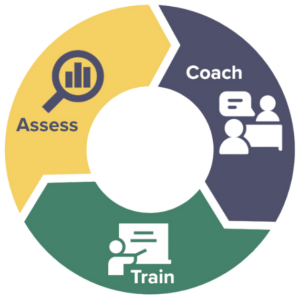Click here to download a PDF of this article
People are conditioned to applaud heroes. Across popular culture, we’re caught up in a tide of heroic imagery and scenes that have us cheering for more, whether it’s the latest superhero film or a goal scored by your third grader as time ticks off the clock. Leaders are no different here. In fact, many executives rise up because they have been so good at winning on a personal level.
Yet time and time again, we understand it is via teamwork that the real magic happens. Efficient and productive teams are the engines of success for your organization, just like they are on movie sets and in professional sports. We are accustomed to the power of teamwork, and we know when we see it. But creating great teams is difficult. Increasingly, leaders – you – are faced with many obstacles that didn’t even exist a handful of years ago.
The task before you is straightforward. To win in the marketplace, now and in the future, leaders must create, grow, and maintain high-performing teams. This only happens, though, if executives and others are willing to address the difficult task of culture change and infuse transformation across the organization, from the board of directors to the front line.
Let’s take a look at diversity, equity, and inclusion (DEI) from this perspective. In many companies, a DEI focus is driven by wanting to do the right thing ethically and morally, improve disparities, and advance social justice. However, there is also a transformative business impact of implementing DEI programming to create stronger decision-making structures, improve internal efficiency, and drive better business outcomes.
Here’s where the full power of cross-functional teams provides a case study in strong leadership.
To reap the full bottom-line benefits of diversity, organizations must learn to separate business-focused DEI programs from corporate social responsibility initiatives that work toward social justice. One way to do this is by reframing what diversity means – and what diversity can do – in business. It isn’t just race, gender, and sexuality that matter; it’s diversity of skills, expertise, experience, and perspective that drive business results.
At The Diversity Movement – the DEI strategy partner to 100+ organizations – here’s what we’re seeing across our client spectrum and hearing in conversations with corporate executives:
Diverse teams are yielding measurably better business results by improving decision-making and innovation. Diverse teams are driving business forward.
If you’ve read the studies from McKinsey and Company, Accenture, Deloitte, and others, you probably already know the overwhelming business case for DEI. Diversity and inclusion in the workplace correlates with greater productivity, collaboration, employee engagement, employee retention, profitability, and business growth.
As David Rock and Heidi Grant argue in the Harvard Business Review article “Why Diverse Teams are Smarter,” homogeneity is a trap, creating lackluster outcomes and increased risk. “Though you may feel more at ease working with people who share your background,” the authors write, “don’t be fooled by your comfort. Hiring individuals who do not look, talk, or think like you can allow you to dodge the costly pitfalls of conformity, which discourages innovative thinking.”
Therefore, your directives are simple – get more diversity into your teams and create a culture of inclusion so diverse teammates feel empowered to contribute their best work consistently. Inclusion is the key that unlocks the power of diversity on your teams. As Erik Larson writes for the decision intelligence platform Cloverpop, “diversity can increase friction 15%, but inclusion boosts results 60%” making the friction worth your while.
In Larson’s words, “inclusion instantly activates existing age, gender, and geographic diversity for better decision making.” In other words, even if it’s initially difficult to create diverse, cross-functional teams, the bottom line impact will pay for itself exponentially.
Here are the key statistics you should know:
- Teams make better decisions than individuals 66% of the time, and diverse teams make better decisions 87% of the time. (Cloverpop)
- Diversity can increase friction 15%, but inclusion boosts results 60%. (Cloverpop)
- Diversity increases innovation 20%, improves decision-making quality 20%, and reduces risk 30%. (Deloitte)
Cross-functional teams are diversity in action. In our definition, a cross-functional team is any group of key decision-makers and needle-moving employees from different departments with different skill sets and different areas of expertise who work together as a task force for the organization’s benefit.
Cross-functional teams eliminate silos, reduce rework, and increase communication
Let’s say you’re an SaaS (Software as a Service) company developing a new add-on product that integrates with your flagship offering. You have a product development team of fifteen engineers tasked with bringing the add-on to market. Their impulse, every time, will be to build that product in their product-development silo – to take charge of the strategy and execution from beginning to end, then deliver a market-ready result they believe is as strong as it could possibly be. But if they’re allowed to do that, it definitely won’t be.
Here’s how it could be stronger.
Instead, imagine two or three key leaders from your product development department – whether leaders by title or simply by influence and force of personality. As part of the development process, those product experts become part of a cross-functional, cross-departmental task force that also includes one or two key leaders from marketing, sales, operations, client services, and maybe even some departments that at first seem unrelated, like media relations or human resources. That team meets for an hour every week to discuss how the product is developing and then creates action items for the organization, specific to this particular product.
As a result, rather than working in an echo chamber, the product development team is hearing from client services about how the add-on will solve a critical problem for existing customers, so they can really home in on exactly what the customer’s pain point is. They’re hearing from the operations team about how the product could create enough additional revenue to hire two more engineers, allowing the product development leaders to spend less time fixing existing bugs and more time dreaming of the next big idea. And they’re hearing from sales and marketing specialists about how the product will be sold and positioned in the marketplace and how fixed or moveable the delivery deadline can be to meet market expectations.
At the same time, the sales and marketing teams now have more accurate knowledge of what the product will be, when it will be ready for promotion, and how to talk about it in content and in prospect meetings. Similarly, the operations team has a better idea of how many hours this product takes to develop, what steps are involved, and what the end-result may be. The client services team isn’t left to guess just when the add-on will be ready for customers, but can speak with authority in client conversations and manage people’s expectations, generating anticipation and excitement only when appropriate in the process.
Make bolder decisions at an accelerated pace while reducing risk
In this example, it’s easy to see how diverse teams work to improve collaboration, innovation, and decision-making across the organization. Diverse skill sets bring diverse perspectives, which in turn generate stronger results specifically because they create a guardrail against uninformed or ill-informed decision-making. Strong cross-functional teams improve and accelerate the decision-making process while reducing risk.
With a wider and deeper range of perspectives at the table, you have a clearer picture of the challenges you’re facing, solutions, strategies, options for execution, and more – regardless of what obstacles arise. You are better able to anticipate market needs and desires, and you can respond quickly with organizational agility and resilience to meet the market where it is. With cross-functional teams in place, your decision-making model is fundamentally stronger because you’re tapping into a diverse team of expert advisors.
Innovation and agility thrive where the best idea wins
Cross-functional teams also push innovation, creativity, and agility across the organization by creating a culture where people can expect to have their perspectives challenged and countered, creating an environment where the best idea wins. It starts by setting clear expectations about the intention and objectives of each cross-functional team.
Leaders who establish cross-functional teams should make it clear that their purpose is to eliminate silos, guard against narrow or hierarchical thinking, and discover the true best way forward. If you’re the person leading cross-functional team meetings, it’s critical that you know best practices for inclusive meetings and the core 10 actions you can take to be more inclusive at work.
If you’re an employee who’s asked to take part in a cross-functional team or meeting, you have a clear responsibility as well. First, as much as it is your leader’s job to make space for you to share your ideas, it’s your job to step into that space and speak up with your unique perspective. The mix of ideas and informed opinions is good for the organization. Remember, you’ve been asked to take part because of your unique perspective and talents. If you don’t accept that responsibility, neither you nor the organization can reach its full potential.
Tips for ensuring cross-functionality in meetings and on projects
Here are the actionable takeaways you need to know to get started right away in creating and nurturing cross-functional teams across your organization.
- Every big project should have a cross-functional team in charge of strategy and execution. Include people from multiple departments with varied skill sets and who represent all levels of the organization – not just people who are leaders by title.
- For minor projects in single departments, you can guard against lackluster decision-making by requiring teams to tap external advisors for cross-functional and diverse perspectives. For instance, your content marketing team should solicit input on critical publications from 3-5 external reviewers, whether that means tapping your Vice President of Innovation, Chief Human Resource Officer, or professionals and partners who work outside your organization.
- Demographic diversity and representation still matter. Just because cross-functional teams center around diversity of experiences doesn’t mean you get a free pass to include only a single race, gender, age group, or professional level. When you’re crafting these teams, be intentional about people’s identities and dimensions of diversity. Remember: they’re not just bringing their professional resumes to the table. Each person is bringing a lifetime of experiences from their unique cultural background.
When we expand our definition of diversity and integrate inclusion into the fabric of how our organizations operate and succeed, our businesses reap the overwhelming benefits. We become more resilient, agile, innovative, and collaborative, leading to better bottom-line results and a more enjoyable, dynamic work environment – one where people are expected and encouraged to contribute their best work, consistently.
Sure, there’s plenty of focus on superheroes, individuals and heroes who are successful on their own. But, smart executives know that creating teams filled with stars raises the entire organization to a higher level – one with the range and strength of a choral performance, not just a solo. Cross-functional teams are one key move in making that success a reality.
Shelley Willingham, CDE, is Vice President of Business Strategy. She is an entrepreneur, business strategist, and marketer who uses an equity lens to help clients achieve better business outcomes.
Bob Batchelor, PhD, is Director of Public Relations and Publications, as well as an award-winning cultural historian and author of numerous books.
Donald Thompson, CDE, is co-founder and CEO of The Diversity Movement. With two decades of experience growing and leading firms, he is a thought leader on goal achievement, influencing company culture, and driving exponential growth. His book, Underestimated: A CEO’s Unlikely Path to Success will be published Fall 2022.














